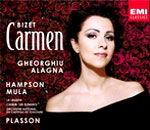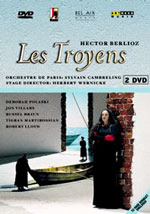|
|
|
[INDEX]
|
CD/DVD Reviews: Berlioz:
Les Troyens (ArtHaus), Alagna/Gheorghiu Carmen (EMI), E. Schumann’s
Schubert Lieder (Naxos), Wagner: Der fliegende Holländer/Reiner/1950
(Naxos)
By Philip Anson / February 16, 2003
On the Aisle |  |
Bizet: Carmen
Plasson/Orchestre National du Capitole de Toulouse
EMI 724355743428 (3 CD- 157.31)
5 stars $$$
 This
intriguing recording, starring French tenor Roberto Alagna and his wife,
Rumanian soprano Angela Gheorghiu, is a remarkable and unique achievement.
Almost a period reconstruction of Bizet’s opera, the aesthetic of this
recording is small-scaled, intimate, and chamberish, as it might have
been heard at its Paris’s Opéra Comique debut in 1875 (though here we
have the sung recitatives, not the spoken dialogue). Though the recitatives
make it opera rather than opera-comique, the emphasis is on the words
and drama. The predominately French cast interact tightly and give every
word its due weight -- the opposite of what you get at a Metropolitan
Opera Carmen, where vast, blurry choruses bellow, tenors yell and sopranos
screech in phonetically approximate French. The title role of Carmen is
usually sung by a mezzo but soprano Gheorghiu acquits herself well as
a singing actress. With her old-fashioned Eastern Block style she sounds
more classy than most Carmens. Alagna, with his ardent throaty tenor,
sounds more adolescent than most Don Jose’s. The odd vocal pairing works
thanks to the unifying force of the precise and sensitive Orchestre National
du Capitole de Toulouse under Michel Plasson. Every piccolo, flute, and
trumpet sounds clear and natural. Thomas Hampson is an odd Escamillo:
lighter than usual, and with good diction. Albanian soprano Inva Mula
is a rather forceful Micaela; its hard to believe anything frightens her.
Joie suprême: the French choruses are tasteful, modest and crisp.
Two novelties: the recording includes a recently discovered (and wildly
different) alternative entrance aria for Carmen, in addition to the standard
Habanera; and Moralès’s rarely heard Act I scene and pantomime. Notes
and libretto in English, French and German. Recommended, despite the fact
that EMI stretched the recording over 3 full-price CDs when 2 would have
sufficed. This
intriguing recording, starring French tenor Roberto Alagna and his wife,
Rumanian soprano Angela Gheorghiu, is a remarkable and unique achievement.
Almost a period reconstruction of Bizet’s opera, the aesthetic of this
recording is small-scaled, intimate, and chamberish, as it might have
been heard at its Paris’s Opéra Comique debut in 1875 (though here we
have the sung recitatives, not the spoken dialogue). Though the recitatives
make it opera rather than opera-comique, the emphasis is on the words
and drama. The predominately French cast interact tightly and give every
word its due weight -- the opposite of what you get at a Metropolitan
Opera Carmen, where vast, blurry choruses bellow, tenors yell and sopranos
screech in phonetically approximate French. The title role of Carmen is
usually sung by a mezzo but soprano Gheorghiu acquits herself well as
a singing actress. With her old-fashioned Eastern Block style she sounds
more classy than most Carmens. Alagna, with his ardent throaty tenor,
sounds more adolescent than most Don Jose’s. The odd vocal pairing works
thanks to the unifying force of the precise and sensitive Orchestre National
du Capitole de Toulouse under Michel Plasson. Every piccolo, flute, and
trumpet sounds clear and natural. Thomas Hampson is an odd Escamillo:
lighter than usual, and with good diction. Albanian soprano Inva Mula
is a rather forceful Micaela; its hard to believe anything frightens her.
Joie suprême: the French choruses are tasteful, modest and crisp.
Two novelties: the recording includes a recently discovered (and wildly
different) alternative entrance aria for Carmen, in addition to the standard
Habanera; and Moralès’s rarely heard Act I scene and pantomime. Notes
and libretto in English, French and German. Recommended, despite the fact
that EMI stretched the recording over 3 full-price CDs when 2 would have
sufficed.
Berlioz: Les Troyens
Cambreling/Salzburg 2000
ArtHaus DVD (2 DVD )
5 stars $$
 Opera
on DVD has come a long way in a short time. Gone are the days of badly
dubbed, undirected singers moving in and out of frame, the static one-shot,
and raw colour imbalances. Now the best DVDs combine the thrill of a live
performance with the sophisticated editing of television and the finest
digital sound. Take for example the new release of Herbert Wernicke’s
staging of Hector Berlioz’s grand opera masterpiece Les Troyens from the
2000 Salzburg Festival. This is not just an excellent opera DVD, but may
well be the best recording (either visual or audio) of Les Troyens on
the market. Dramatically, musically, and cast-wise, it certainly beats
the current Metropolitan Opera production of the opera. Opera
on DVD has come a long way in a short time. Gone are the days of badly
dubbed, undirected singers moving in and out of frame, the static one-shot,
and raw colour imbalances. Now the best DVDs combine the thrill of a live
performance with the sophisticated editing of television and the finest
digital sound. Take for example the new release of Herbert Wernicke’s
staging of Hector Berlioz’s grand opera masterpiece Les Troyens from the
2000 Salzburg Festival. This is not just an excellent opera DVD, but may
well be the best recording (either visual or audio) of Les Troyens on
the market. Dramatically, musically, and cast-wise, it certainly beats
the current Metropolitan Opera production of the opera.
Historians will be interested in this DVD as a memento of the last season
of Salzburg’s controversial leader Gerard Mortier. It also represents
one of the final works of German stage director Herbert Wernicke, who
died in April 2000, during rehearsals.
The cast is strong. American soprano Deborah Polaski takes the double
leads of Cassandra and Dido. Though a stiff actress, substituting rigid
dignity for expressiveness, Polaski is a credible sorceress/queen. While
not as lush as Jessye Norman or as classically pure as the womanly Régine
Crespin, Polaski sings loudly and accurately. Her Aeneas is American tenor
Jon Villars, who sings the high-lying role with ease, though this strapping,
overgroomed young man is strangely supine when it comes to wooing Dido.
Canadian baritone Russell Braun sings Chorèbe with a warm, full sound,
but his on-camera grimacing is regrettable. Veteran British bass Robert
Lloyd is an excellent major-domo-ish Narbal. Yvonne Naef is a juicy voiced,
buxom Anna. Tenors Ilya Levinsky and the cute Toby Spence sing their cameo
arias cleanly. The Austrian choruses, deploying a pure and delicate tone,
treat the text with exceptional respect. Stars and chorus are all good-looking,
and everyone’s French diction is virtually perfect.
The Salzburg Chamber Orchestra and the Orchestre de Paris play irreproachably
and with remarkably idiomatic sensitivity (considering they had never
played the work before) under Sylvain Cambreling.
Wernicke’s modern production updated the visuals from the ancient Mediterranean
to a generic contemporary military society. The unit set represented a
white ice-shelf, backed by two curved white walls with a single upstage
opening for entrances and exits. In Part I, set in Troy, we see a wrecked
plane and flaming ruins through the opening. In Part II, set in Carthage,
we see a sunny sea shimmering in the background and, during the love duet
“Nuit d’ivresse”, a starry sky. Rather than focusing exclusively on the
fateful Aeneas-Dido love story, Wernicke’s production highlights the clash
of ideologies between the military “hunter” Trojan society and the pacific
“gatherer” Carthaginian society. To emphasize what might be called tribal
differences, Wernicke has the belligerent Trojans wear red gloves, SWAT
uniforms, and carry machine guns. The pacific Carthaginians wear blue
gloves and fashionable leisure outfits, sing hymns to peace and plenty,
and quaff champagne. The Trojans import passion and strife to Carthage,
setting off a train of events that results in Dido’s famous suicide.
The choruses were marshalled efficiently, and the protagonists were centred
on the mostly bare stage. The Royal Hunt was acted in subdued pantomime,
as Berlioz wished, but the ballets were cut. The camera work is deft and
pertinent to the action. Assembled from several performances, the audio
continuity is seamless. I noted only one small visual continuity glitch:
Dido’s funeral pyre seems to change between two takes. The audio sound
is excellent.
Wagner: Der fliegende Holländer
Reiner/Metropolitan Opera and Chorus
Naxos 8.110189-90 (2 CD- 128.21)
2 stars $
This radio broadcast recording from Dec. 30, 1950, captures the run of
Flying Dutchmans in which German bass-baritone Hans Hotter and Swedish
baritone Sven Nilsson (a coarse Daland) made their Metropolitan Opera
debuts. Astrid Varnay was only 32 when she sang this Senta but hers is
the voice of experience: hard, strident, and durable where innocence,
sweetness and lyricism would have been preferable. Hotter matches Senta
bellow for bellow, resulting in a hog-calling contest that is hard on
the ears. Reiner goads the Met Orchestra into a maelstrom of dramatic
sound that might have been thrilling live, but comes across on CD as angry
and forced. Producer Ward Marston has done his best with the pirated radio
tapes but the splices are glaring, making this a collector’s item, not
for the average opera lover.
Elizabeth Schumann: Schubert Lieder
Naxos 8.110731 (77.35)
2 stars $
Reputations are fickle. On the basis of this re-issue of Schubert songs
by the famous German soprano Elizabeth Schumann (1888-1952), its hard
to know what the fuss was about. Recorded between 1927-1945, the earlier
songs (before 1933) demonstrate - at their best - character, expressivity,
and style. At their worst, the songs sound twee, hard and edgy. After
1936 Schumann’s voice hardens unpleasantly, sounding dry and aged, though
she was only in her late 40’s. Her style is smart and artful like Ameling’s,
but without the Dutch singer’s tonal beauty. Producer Marston uses the
best sources, so the sound is clear with only light surface hiss. Notes
in English only. No song texts. For specialist collectors only.
[INDEX]

|
|
|


